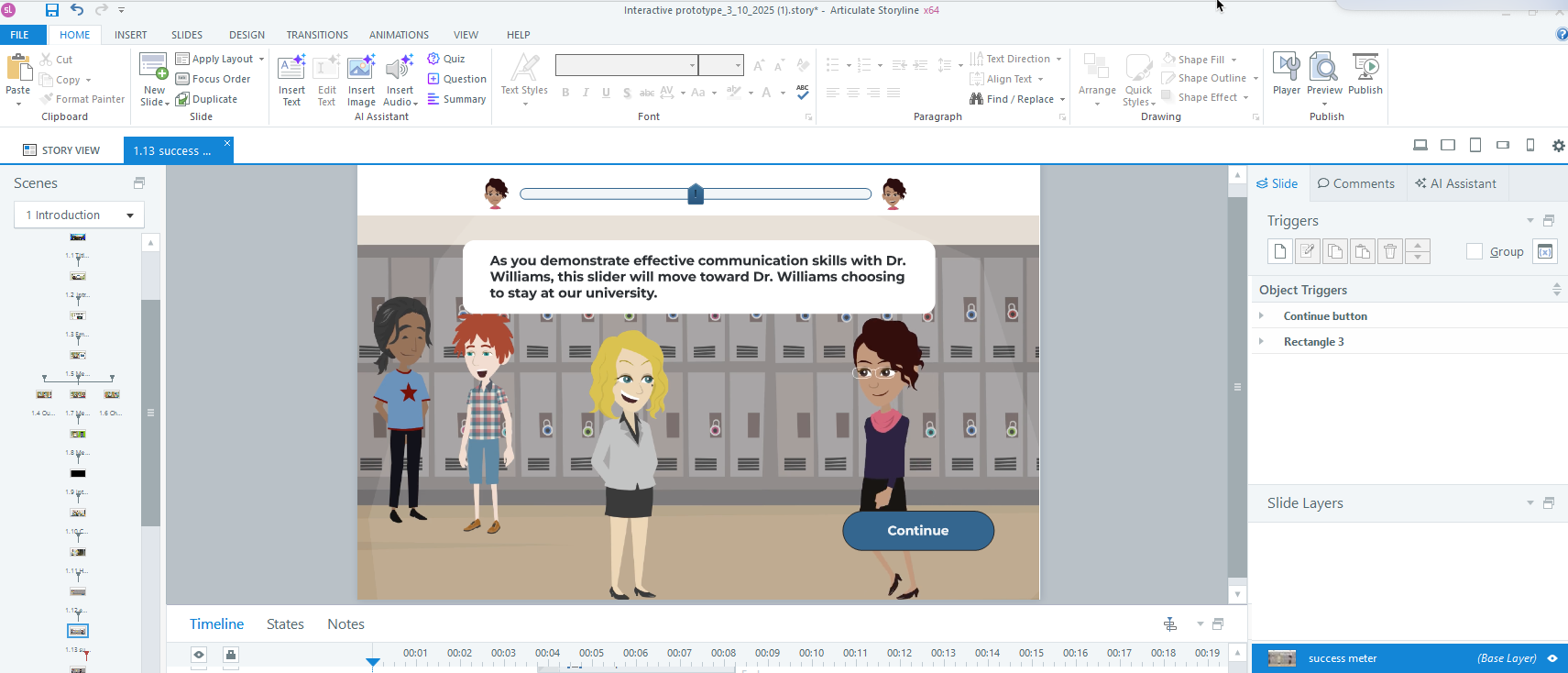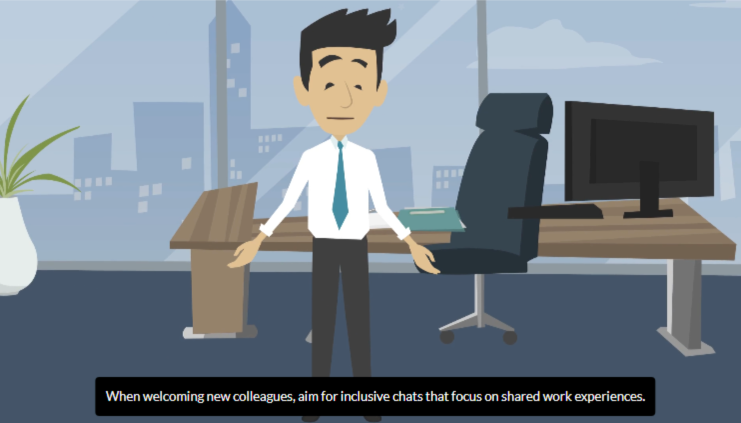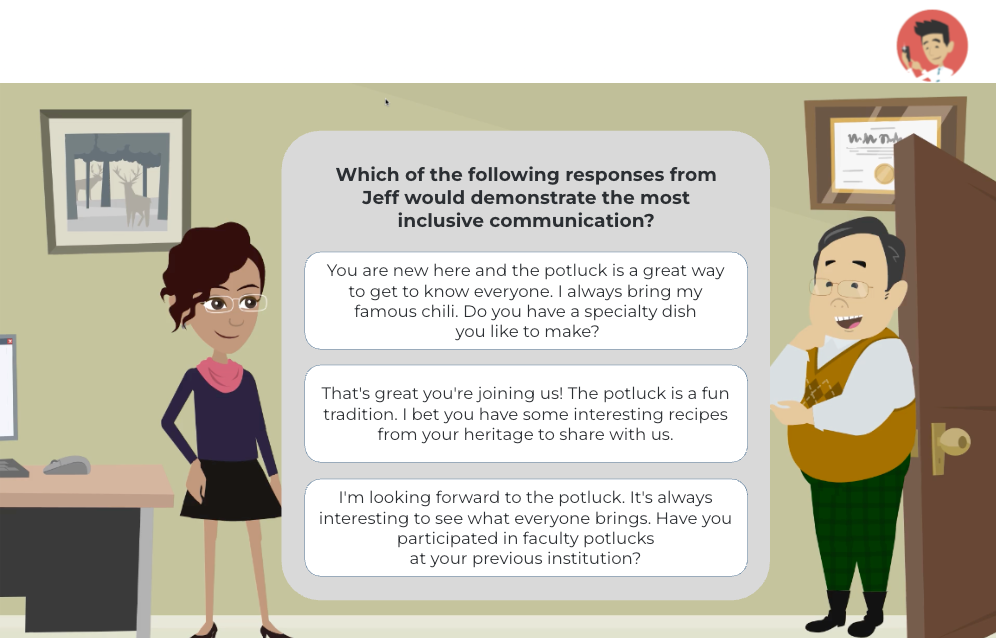SCENARIO-BASED eLEARNING
Don’t Let Them Leave:
Inclusive Communication for Faculty Retention
This concept project is an immersive scenario-based learning experience designed to help faculty develop inclusive communication practices that support the retention of diverse colleagues, particularly faculty of color. Through real-world scenarios, faculty members learn how their everyday interactions can foster—or erode—a culture of inclusion.
-
Faculty aiming to develop inclusive communication skills to better retain and support colleagues of color.
-
Instructional design, action mapping, storyboarding, visual design, eLearning development, authoring
-
Articulate Storyline 360, Figma, MindMeister, Adobe Photoshop, Vyond, Google Docs
The Problem
The Vista University system is a conceptual organization designed for this learning experience focused on inclusive communication in higher education. They face high turnover rates among faculty from diverse backgrounds, creating financial instability and increased workloads for remaining faculty. Communication issues significantly contribute to poor retention of faculty of color, prompting their strategic goal of increasing retention rates by 30% within 12 months. Faculty exit interviews, climate surveys, and consultations with diverse faculty members confirmed the presence of communication challenges and microaggressions in daily interactions that fostered feelings of exclusion and contributed to the departures.
The Solution
After identifying the retention problem, I conducted faculty interviews and consulted with diversity, equity, and inclusion subject matter experts to determine root causes. I discovered that faculty members lacked both awareness of microaggressions and practical skills for inclusive communication in academic settings.
To address these gaps, I proposed a scenario-based eLearning experience where faculty practice identifying inclusive and non-inclusive communication, responding to diverse colleagues in supportive ways, and addressing problematic statements in a risk-free environment before applying these skills in their actual department interactions.
My Process
In order to plan and create an effective learning experience addressing faculty retention issues, I used the ADDIE Model of instructional design. This systematic approach guided me through analyzing the university's 70% faculty of color turnover problem, designing branching scenarios with authentic communication challenges, developing interactive prototypes with visual feedback mechanisms, implementing with accessibility considerations, and evaluating progress toward the 30% retention improvement goal. Throughout each phase, I incorporated stakeholder feedback to ensure the learning experience authentically reflected faculty experiences while providing practical inclusive communication strategies.
Action Map
For this project, I collaborated with Dr. Lee, an Associate Professor specializing in Diversity, Equity, and Inclusion at SUNY Albany, to create an action map addressing faculty retention challenges. Working with Dr. Lee, we identified three high-priority communication scenarios that impact faculty of color experiences: welcoming interactions, responding to discrimination, and navigating social events. Rather than focusing on abstract diversity concepts, our action map emphasizes specific communication behaviors faculty need to demonstrate. This behavior-centered approach ensures the learning experience directly supports the university's goal to increase faculty of color retention by 30% within 12 months.
Text-Based Storyboard
After identifying key communication behaviors with Dr. Lee, I created a comprehensive text-based storyboard following Dr. Williams, a new Black female biochemistry professor, through three authentic faculty scenarios and questions.
For each scenario and question, I crafted dialog choices with corresponding consequences that show the real impact of communication decisions on faculty retention. When learners choose inclusive approaches, they see Dr. Williams' positive internal thoughts; when they make mistakes, they witness her disappointment and consideration of leaving.
I incorporated Dr. Lee as a mentor character providing guidance only when needed, respecting experienced faculty's time while offering expertise on demand.
The storyboard includes a visual "retention meter" showing the direct impact of communication choices, ensuring every element contributes to behavior change and improved retention outcomes.
Visual Mockups
After finalizing the storyboard, I developed the visual design strategy for our faculty retention learning experience. I began by creating a mood board that captured the professional yet welcoming atmosphere of a university campus, incorporating diverse faculty imagery, academic settings, and color palettes that evoke trust and inclusion. The mood board helped establish the visual tone for representing sensitive interactions while maintaining a positive learning environment.
Next, I designed a comprehensive style guide to ensure consistency throughout the experience. The style guide defined our typography (using accessible sans-serif fonts for primary text), color scheme (featuring the university's colors with additional accent colors to represent communication effectiveness), UI elements (including the mentor button and communication meter), and character styles for representing diverse faculty members in a respectful, authentic manner.
I then developed wireframes for each slide type in our learning experience, including title, introduction prompts, scenario presentation, question/decision points, etc. These wireframes established a consistent layout structure while accommodating different content needs. After iterating on the wireframes based on usability principles, I created high-fidelity mockups showing exactly how each screen would appear to learners, complete with realistic dialog, communication meter states, and mentor interactions. These mockups were crucial for gathering stakeholder feedback before proceeding to development.
Interactive Prototype
Before full development, I created an interactive prototype combining Vyond's animation capabilities with Articulate Storyline 360's interactivity features. The prototype demonstrated the first scenario of the faculty retention learning experience, using professionally animated videos to portray Dr. Williams' journey as a new faculty member. These visual narratives enhanced the three decision points and their consequences, making them more impactful and relatable while creating an authentic representation of faculty experiences. Key interactive elements included a communication meter using Storyline's slider function that dynamically responded to user choices, and a fully functional Dr. Lee mentor character who provided video guidance during critical decision-making moments.
The design was grounded in established instructional design theories. I applied Cognitive Load Theory by developing Vyond videos that presented complex faculty interactions through dual visual and audio channels, reducing extraneous cognitive load and allowing learners to focus on core concepts. The communication meter provided just-in-time feedback, further optimizing cognitive resources. I simultaneously leveraged Situated Learning Theory by creating authentic scenarios with Dr. Williams that mirrored real workplace challenges, incorporating meaningful decision points with consequences that illustrated the social impacts of communication choices. The Dr. Lee mentor character reinforced the community of practice aspect where experienced members guide newcomers, creating a balanced learning environment that addressed both cognitive considerations and contextual authenticity.
The technical implementation utilized Articulate Storyline 360's advanced features to create an engaging and accessible experience. I programmed dynamic variables to track user choices, designed custom states for interactive buttons with visual feedback, implemented precision timers for appropriate pacing, triggers (standard and conditional), and added captions for improved accessibility. The Vyond videos enhanced authenticity through cinematic techniques including strategic camera movements, emotionally-targeted zoom effects, and carefully balanced background music that supported the narrative without overwhelming the content. These elements created a seamless integration of passive and active learning moments throughout the experience.
Full Development
Following multiple rounds of user testing with faculty members, DEI specialists, and an experienced instructional designer, I methodically refined all aspects of the prototype based on their feedback. These evidence-based improvements informed the full development of all scenarios in Articulate Storyline 360, resulting in a polished final product that effectively addressed faculty retention challenges through authentic, theory-driven scenario-based learning.
I am most proud of developing skills with Vyond animation to create authentic learning experiences. When stock videos couldn't capture nuanced faculty interactions, I embraced learning Vyond's character animation, camera techniques, and scene composition. I established a consistent visual design while experimenting with dynamic camera angles, strategic panning, and emotional zoom effects to highlight key interactions. Through this process, I created custom animations that effectively portrayed subtle communication dynamics while maintaining visual continuity across all design elements. Seeing faculty members recognize their workplace experiences in these cinematically enhanced animations validated my learning efforts.
The implementation in Articulate Storyline further enhanced the learning experience through interactive elements that complemented the videos. The integration of a ‘retention meter’ provided learners with immediate visual feedback on their communication choices, reinforcing learning objectives while maintaining engagement. I prioritized accessibility by implementing captions throughout all video content, ensuring the learning experience was inclusive for all faculty members.
Results & Takeaways
This scenario-based learning experience was enthusiastically received by stakeholders, with a university DEI expert praising its "exceptional" representation of faculty interactions and noting that "this level of authenticity is rarely achieved in DEI training materials," while a former faculty participant remarked that the venting scenes were so thoughtfully scripted they "brought back memories of similar calls" she had experienced personally.
“The authentic representation of faculty interactions in these animations is exceptional. The scenarios accurately capture the subtle microaggressions and communication challenges that new faculty members from diverse backgrounds face in real academic settings. This level of authenticity is rarely achieved in DEI training materials.”
“I really liked the scenes where she calls her friend to vent. Unfortunately they brought back memories of similar calls I’ve had with friends, but that speaks to how thoughtful you were in writing the script!”
After completing this project, I gained valuable insights into creating effective scenario-based learning for sensitive topics like faculty retention and inclusive communication skills. I discovered the importance of iterative testing and feedback, especially when creating scenarios that authentically represent challenging workplace interactions for faculty of color. The process taught me how to balance theoretical instructional design principles with practical user experience considerations, ensuring that interactive elements like the communication meter provided meaningful learning opportunities without overwhelming cognitive resources. This project has strengthened my commitment to creating learning experiences that are not only engaging but also grounded in evidence-based design principles that support genuine behavior change toward more inclusive working environments.


















